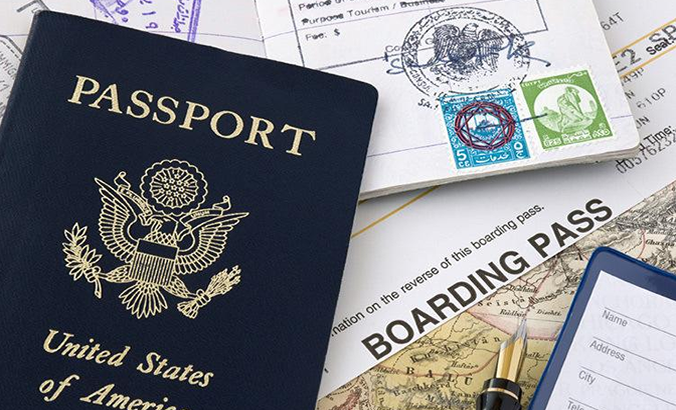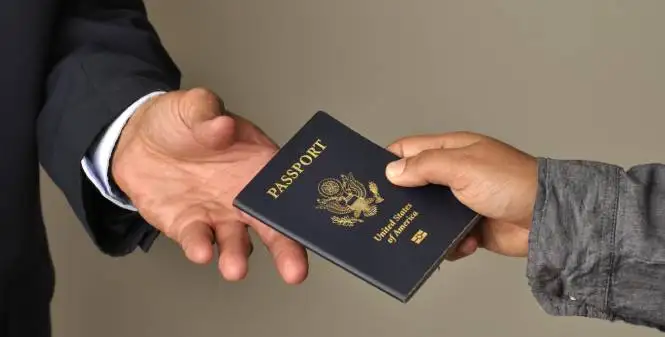Authority for Issuing Passports
In a passport, the phrase “Passport – Place of Issue or the Issuing Authority” designates the location where the document was issued. Previously, the application was processed and the passport was issued by a number of different passport offices and agencies. Previously, the name of the city or state was mentioned in the passports issued by these organizations. On the passport issued in the US and printed as the US Department of States imprinted in black ink, the term “place of issue” has now been replaced by the term “Issuing Authority.” It typically appears on the passport book’s photo page.
Many people are unsure of what to write in the “Passport – Place of Issue” or “Passport – Issuing Authority” field of the visa application form.
If the “National Passport Centre” was listed in your passport when it was issued years ago, simply mention it in the same way on your visa application.
You must indicate this on the visa application form if the passport’s ‘Issuing Authority’ section reads ‘US Department of State’. Write down the name of the Consulate or Embassy that issued your passport if you are a foreign citizen and it was issued by one when you were a resident of the US.
The location of the passport’s issuance will be noted there if it was issued by a US Consulate or Embassy outside of the nation. Regarding all the nations, this is much the same.
Who has the authority to grant passports? Are there any further locations where passports can be obtained?
The only entity with authorization to issue passports to anyone in the US is the US Department of State.
Other legitimate passport offices or centers that process passport applications can be found all around the United States. Please visit the US Department of State-Bureau of Consular Affairs for further information about the various passport offices.
To make it simpler for candidates to approach for the visa application procedure, the US Passport Services has also designated a large number of public sector offices as passport acceptance facilities. These facilities, which include post offices, state courts, libraries, county offices, and a few more offices, offer the option for applicants to apply for passports.

What do different sections of the passport indicate:
The US Department of State has divided US passports into various categories based on their intended use. These passports have various colored covers so that officials can distinguish between them: Service (grey cover), Official (maroon cover), Diplomatic (black cover), Refugee (blue or green cover), Re-entry permit, Emergency passport, and US passport card are the different types of passports.
The many sections of the passport each have a distinct meaning. The ‘biodata page’ and the signature page’ are the two main pages in a passport.
The biodata page includes all the information about the passport’s owner and the document itself:
- Name of the passport holder, nationality, date of birth, place of birth, gender
- Photograph
- The place of issue or the Issuing Authority
- Type of Passport
- Passport Book Number
- Passport issuance Date
- Passport expiry date
- Code of the issuing country
- Endorsements
By placing the passport under the scanner, the authorities can read the machine-readable zone (MRZ) at the bottom of the biodata page to obtain all the information on the passport holder and the passport booklet.
The passport holder’s signature appears on the signature page. It must be signed by the parents of the child of a person who has the power to sign on behalf of the passport holder if the passport holder is unable to sign for whatever reason, such as in the case of toddlers or youngsters. Without the passport holder’s signature, a passport is deemed void. The ‘Place of Issue/Issuing Authority’ and the numerous establishments or centres permitted to issue passports have been discussed so far.let’s move on to understand what OCI card refers to.

What is an OCI card?
The Overseas Citizenship of India, or OCI, is a type of permanent residency available to those of Indian ancestry who have left India, made a home elsewhere, and become citizens of that nation. Only people with the option of having dual citizenship in the nation they now reside in are eligible for the OCI card.
Eligibility Criteria for OCI Cards
For a person to be eligible to apply for an OCI card, there are some requirements. For additional details on who qualifies for OCI under Indian law, please visit the Bureau of Immigration-Government of India’s official website.
Possessing an OCI card has various benefits, but it also has some restrictions.
Let’s start by discussing the advantages:
Unrestricted travel several times to and from India.
You will be issued a visa that is good for life and can be used for a number of legal activities.
Work without a work permit in any private organisation in India.
On both domestic and foreign issues, treat NRIs and Indian residents equally.
No matter how long you visit India, you are not required to register with the local police authority.
For occupations like those of doctors, nurses, lawyers, chartered accountants, architects, and dentists, you will be given equal pay and benefits.
The following are some restrictions on having an OCI card:
Voting is not permitted in India.
not allowed to join any political or parliamentary organizations.
You won’t be allowed to work for the government, another government agency, or any other public sector organization.
cannot hold a constitutional office or run for one.
You lack the legal right to obtain an Indian passport.
Real estate connected to plantations or agriculture cannot be purchased
The process involved in the application of an Overseas Citizenship of India (OCI) card:
When submitting an OCI application, several crucial actions must be taken. The detailed procedure is described below:
Determine which OCI category you fall under and whether you are qualified to apply for an OCI in
Step 1. To learn more about the categories, go on this link.
Start filling out the OCI application in
Step 2. For various OCI categories, several application forms are available. Please be careful when selecting the category to which you belong.
Step 3: Finish the registration process and pay the required fees: You must prepare the required documents and mail them to the VFS Indian Consular Application Centre by post after completing the online application form. Please be careful to choose the correct VFS Indian Consular Application Centre before you send the documents.
Please keep in mind that your online application is only good for 180 days, therefore you must deliver all required documents before that time.
VFS is not taking any physical applications into consideration because of the COVID-19 outbreak. Only postal mail must be used to send the required paperwork and applications.
Step 4: Register yourself online and set up a profile before submitting your application.
Clicking on this link will take you to the page displayed below:
‘Overseas Citizenship of India’ is the first choice; select it.
To finish the registration procedure, fill out the necessary fields with the right data and then follow the on-screen instructions.
Simply go here if you already have an account. Your browser will open the login page.
where you must sign in using your email address and password.
Don’t forget to select ‘postal’ as the mode of submission.
Step 5: Use the shipping method you selected in the VFS system to send your application hardcopy and other necessary papers.
Step 6: After notifying you through email that they have received your application package, VFS will examine your supporting documentation to confirm it.
Step 7: By clicking on this page, you may follow your application. If you have selected the option, you will also get text or SMS notifications for different status updates.

Traveling Abroad and VISA
Your visa is now one of the most important travel documents you’ll need if you’re going overseas. Therefore, it is crucial to complete the visa application form carefully in order to ensure a quick and easy visa acceptance process. Let’s quickly review the significance of visas and the general instructions for completing the visa application process.
What does VISA stand for? Which sections of the visa application form are there?
The VISA acronym is actually somewhat vague. Either “Verified International Stay Approval” or “Virtual Important Stamp Authorization” are acceptable definitions. In any case, it is the document that grants a traveler permission to enter and exit a nation.
When submitting a visa application form, keep the following general standards in mind:
*First, make sure that every field is filled in and that none is left empty. Simply state “not applicable” or “NA” if something doesn’t apply to you.
For the authorities to grasp your information, make sure to write it clearly.
The signature must match your passport and other official documents and be yours in a whole.
If you are required to disclose a criminal history on the application form, please be honest when doing so.
Take care to be as honest and truthful as possible when providing all the information.
So, to sum up, it can often be very perplexing to provide information in an application form about your passport, the issuing authority, or any other areas within a passport. I sincerely hope that this post was able to help you in any small way.
Does ‘place of issue’ in a passport differs from ‘issuing authority’?
The issuing authority and the issuer’s location are the same. For more information on the many situations when the term “place of issue” or “issuing authority” is used, please refer to the first section of this article.
Are there differing requirements for identifying the “place of issue” of a passport in other nations?
Well, for the most part, it is pretty much the same. It can be found on the passport’s biodata page.
What costs are associated with an OCI card?
A new OCI card costs roughly $295 USD. The cost of reissuing the OCI in the event of loss or damage is around $120 USD.
Follow –Wide Education And Multivlog



